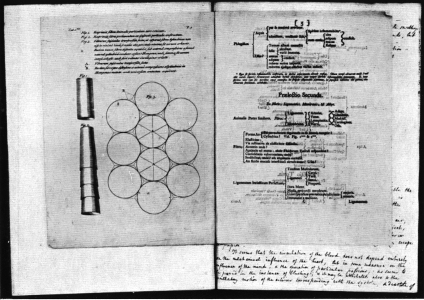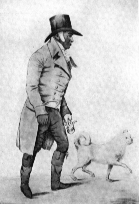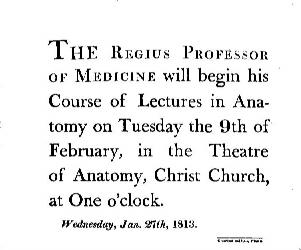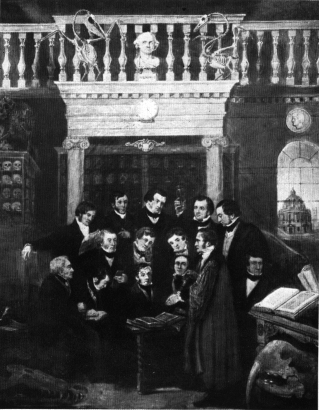The first Anatomical Lecturer was John Parsons (born in 1742), a Westminster student who received his B.A. at Christ Church in 1763. He studied medicine at Oxford, London and Edinburgh, where he was awarded a prize medal by Dr. Hope for the best hortus siccus. He was elected as the first Lee's Reader in 1767, as well as University Lecturer in Anatomy. John Grosvenor, a matriculated surgeon, was elected "Assistant Dissecting Surgeon and received £320 for each course in which he assisted. Chemistry was also taught, indeed Parsons' first syllabus (printed anonymously in ca. 1774(-6?) and reissued in 1804/5) had the title "The Plan of a course of Lectures in Philosphical and Practical Chemistry".

Notes made by F.H. Egerton while attending John Parsons' lectures in 1777.
Parsons' lectures were excellent and he used Nicholls' Compendium Anatomico-Oeconomicum as an outline. The lectures were designed for general philosphers rather than specifically for medical practioners. His opening lecture traced the history of anatomy and then went on:
That when considered with respect not only to the Professions of Surgery and Medicine, Anatomy is of use to men of other professions has been advanced and such a position may very well be supported. As a capital branch of philsophical enquiries it well deserves the investigation of the natural Philospher: To all men whose professions require the aid of eloquence and oratory it must be of use in common with other studies for furnishing that copiousness of language which the knowledge of many sciences will abundantly supply, and that brilliancy and vivid colouring which in oratory is to be produced by a judicious assemblage of proper and chaste metaphors collected together with accuracy from every branch of science. But to the lawyer besides this use it brings with it others more particularly confined to his profession which are not inconsiderable: Assaults are a capital branch of judicial proceedings and on trials of this kind to be able to determine precisely and accurately the nature and consequences of wounds and blows in any part may be of great advantage. Its use to the Painter will be readily admitted when we consider how necessary a knowledge of the parts of the body particularly those immediately beneath the skin are to the formation of a just outline and that to the obtaining perfection in the art of design the variations caused in bodies by sex, age, Position, etc. must be minutely observed. The pursuit of these studies becomes recommended to the Painter by a Michael Angelo, a Titian and a Leonardo da Vinci, the latter of whom left behind him a treatise on the anatomy of the human body with plates to be viewed through a mirror and preserved in the Royal library at Buckingham House.
Parsons' collected a large number of specimens for his lectures "which for neatness and elegance have seldom been surpassed", and for which the Trustees paid £146. However, Grosvenor performed the actual dissections.
Parsons also lectured on Chemistry, sometimes 'Philsophical' and sometimes 'Philosophical and Practical'. In 1769 he obtained his D.M. and began to practise. In 1780 he was elected the first Litchfield Clinical Professor and his personal and professional qualities earned him a large practice in the city and the county. He died in 1785 of a fever and on his death the following poem appeared in the Oxford Journal.
Endowed with all Apollo's Art
Disease and Pain before him fled;
Reluctant Death withdrew his dart,
And Misery raised her aching head.
John Grosvenor.

John Grosvenor (1742-1823); Dr. Lee's Anatomical Surgeon 1768-95.
Grosvenor was the son of the sub-Treasurer at Christ Church and a nephew of one of the Canons (Dr. Tottie). `After serving as an apprentice to a surgeon at Worcester and as House Surgeon at the Lock hospital, he was invited to Oxford to assist Parsons in 1768. They became great friends, and Grosvenor married Parsons' widow in 1791, continuing as Anatomical Surgeon at Christ Church until 1795. He then became proprietor and editor of Jackson's Oxford Journal. In addition to his position at Christ Church, he had been appointed surgeon to the Radcliffe Infirmary, a position from which he resigned in 1817, dying in 1823 at the age of 81. He was one of the first surgeons in England to apply massage to stiff joints and injured limbs.
Whilst at Christ Church he "distinguished himself by extraordinary skill and knowledge and occasionally, in the absence of the reader, he lectured to the students on topics applicable to the dissection of the day".
The Science Library at Christ Church
The laboratory had its own library from the beginning. This included for example "Annalen de Chimie" from volume 1 (1778) and Priestley's works "Experiments on Air".
The Laboratory after Parsons.
Parsons' successor was William Thomson who became a
Student of Christ Church in 1779 (taking his B.A. in 1780) and, after further
studies in Edinburgh (where he took a B.M. and a D.M.), on 15th April 1785
(two weeks after Parsons' death) was elected Lee's Reader. In 1787 he gave
some lectures on the Natural History of Minerals and in 1790 he gave a public
lecture on the bodies of two murderers who had been hanged the previous day.
Shortly after this he resigned all his appointments and died in 1803.
Thomson was succeeded as Lee's Reader by Sir
Christopher Pegge (Dr. Lee's Reader in Anatomy 1790-1816; Aldrichian
Praelector of Anatomy 1801-1822) who was probably the first Regius Professor
of Medicine after Clayton to actually teach anatomy (thereby fulfilling the
conditions of Tomlins Readership).

Dr. John Kidd

A photograph of the interior of the Lee Building whilst a lecture was being given by Dr. Kidd
John Kidd, who succeeded Sir Christopher Pegge, was Dr Lee's Reader in Anatomy from 1816-1844 and Aldrichian Praelector from 1822-1851.
In 1859 the Lee's Reader in Anatomy moved his laboratory to the University Museum when the pathological series (specimens) from the Anatomy School were placed under the charge of the Professor of Medicine. Vernon Harcourt, the Dr. Lee's Reader in Chemistry, took over the building and it became a Chemistry Laboratory until ca. 1942.
Bibliography and Acknowledgements: Dr.P.W.Kent.
İM.C.Grossel (1996)